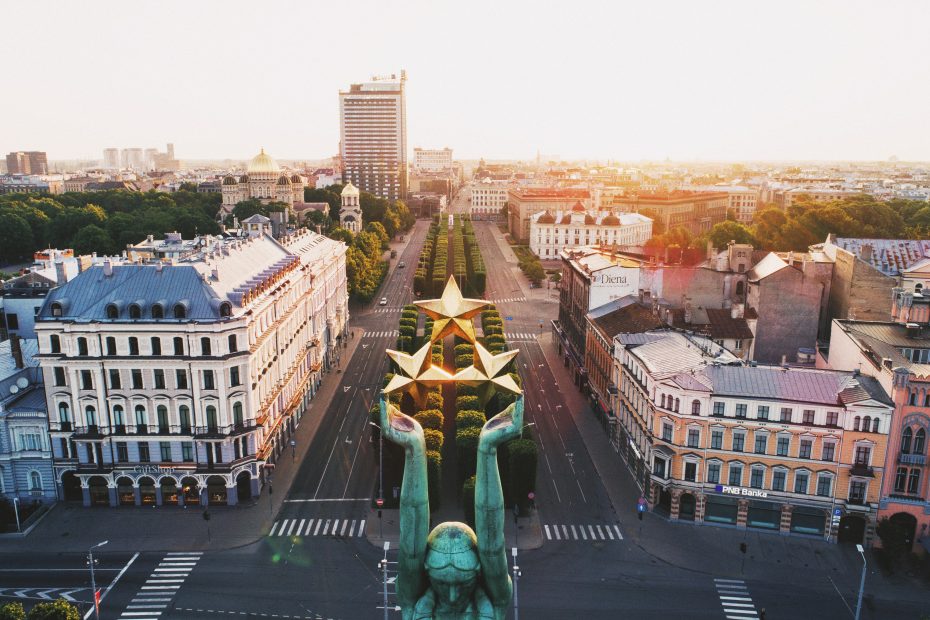Table of Contents
Introduction
Latvia is a country with a rich yet turbulent history, having been ruled over by various powers including the Livonian Order, Poland-Lithuania, Sweden and Russia. The capital city of Riga is the most popular destination for visitors, who flock to see its UNESCO-listed Old Town, Art Nouveau buildings and lively markets. However, there is much more to Latvia than its famous capital! Venture beyond the well-trodden tourist path to discover Latvia’s smaller cities and towns that give an authentic glimpse into the country’s past and culture.
Kuldīga – “Latvia’s Venice”
Nicknamed “Latvia’s Venice” for its pretty waterways, the old town of Kuldīga has one of the country’s most photographed sights – a red brick bridge arching over the Venta River. Wander the charming cobblestone lanes and wooden architecture past quaint cafes, shops and restaurants. Visit the historic Kuldīga Town Hall building and the centuries-old Church of the Most Holy Trinity. One of the top attractions is the mesmerizing Alekšupīte Waterfall cascading in a valley near Kuldīga.
Cēsis – Medieval Atmosphere
The town of Cēsis gives you a taste of medieval Latvia, especially at the imposing Cēsis Castle dating from the 13th century Livonian Order days. Climb the towers for panoramic views over the forested Gauja Valley. The old town lanes lined with Germanic architecture make you feel like you’ve stepped back in time. Don’t miss craft demonstrations and cultural festivals that bring Cēsis’ history to life. It’s a great base for outdoor adventures too like hiking and mountain biking.
Sigulda – Adventure in the Gauja Valley
The stunning Gauja Valley runs right through Sigulda, so it’s a paradise for nature lovers. Go hiking, biking, ziplining or try other active pursuits. Sigulda is sometimes called “Switzerland of Latvia” for its hilly, forested landscapes. The prime attraction is Turaida Museum Reserve featuring a medieval castle, 18th century manor house, traditional wooden architecture and an interesting folk life display.
Rundāle Palace – Latvia’s Versailles
Latvia has its own version of the Palace of Versailles at Rundāle! This grandiose Baroque palace was built in the 18th century for a Duke of Courland. Wander room after lavish, gold-adorned room with painted ceilings and intricate parquet floors. The symmetrically laid out French gardens are also impressive. Rundāle gives you insight into the opulent lifestyle of Latvia’s aristocracy.
Liepāja – Seaside Culture
On Latvia’s west coast, Liepāja is a popular beach destination on the Baltic Sea. It also has a surprising amount of cultural sights for a resort town. There’s a great collection of ornate Art Nouveau-style buildings, evidence of Liepāja’s prosperous trading days. Karosta Prison on the military base outskirts provides a chilling look at Latvia’s Soviet history. Wander the beaches, grab a bite at a seaside cafe, and enjoy Liepāja’s laidback vibe.
Ludza – Tranquil Town in Latgale
In eastern Latvia’s Latgale region, Ludza provides a slice of the Russian influence in this area. Here you’ll find pretty Orthodox churches with onion domes and chimes. Local crafts like weaving, pottery and painting eggs are still practiced. Climb up to the ancient Latgalian hill fort ruins for panoramic views over the tranquil town. With its slower pace of life, Ludza is a nice contrast from the more touristed parts of Latvia.
Bauska – Crossroads of History
The small town of Bauska has an important place in Latvian history, located at the crossroads and border between Latvia and Lithuania. Bauska Castle stands on an island between two rivers with a fascinating multi-layered history under successive rulers. The German and Latvian cultures blend seamlessly in the Old Town’s architecture. Walking tours give insight into the town’s past prominence in trade and commerce.
Conclusion
While Riga deserves its reputation as a top Baltic destination, the real heart of Latvia lies beyond the capital in smaller towns and cities. Each has their own unique appeal – whether its waterfalls in Kuldīga, medieval castles, Art Nouveau architecture, Baltic beach resorts or sleepy hill towns. Venture off the beaten track to experience Latvia’s history and culture up close. But even if you only have time for Riga, you’ll still find delightful sights from Latvia’s diverse past. Wherever you go, Latvia is sure to enchant with its blend of Baltic and European influences.
FAQs
What is the best way to get around Latvia beyond Riga?
Renting a car is the easiest way to travel around Latvia and reach smaller towns. Public transport like buses and trains connects main cities but having your own car allows for spontaneous stops.
How much time do I need to properly see Latvia beyond Riga?
To have time to see the highlights of Latvia beyond Riga, plan on at least 5-7 days. With 10-14 days you could do a more leisurely road trip around the country without feeling rushed.
What language do most Latvians speak?
Latvian is the official language, spoken by most Latvians. A majority of people also speak good English, especially in cities and tourism areas. Russian is widely spoken in eastern regions.
What is the currency used in Latvia?
Latvia uses the euro (EUR) as its currency. Cash and cards are widely accepted in shops and restaurants. ATMs are available in all main towns.
What is the best time of year to visit Latvia?
The summer months of June-August are peak season with long days, more festivals and everything open. September still has mild weather before autumn sets in. Winter offers Christmas markets. Spring has flower blooms, while fall features colorful foliage.
